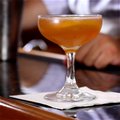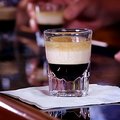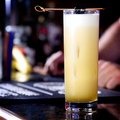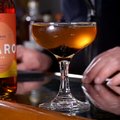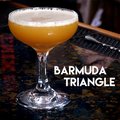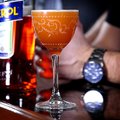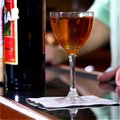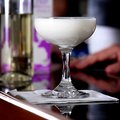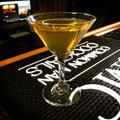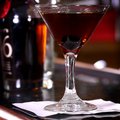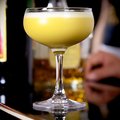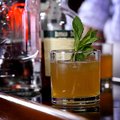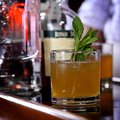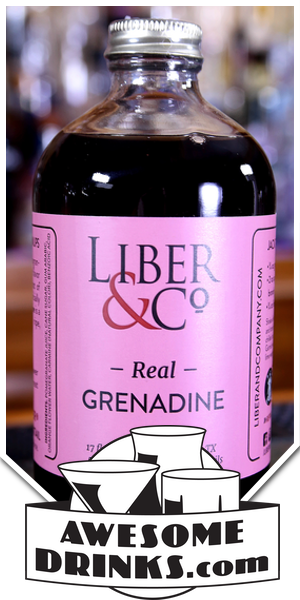Returned 48 result(s) for "whiskey"; page 1 of 4.
The 12 mile limit is a prohibition era cocktail that was named after the 12 mile distance at sea you had to be at to drink alcohol during the Volstead Act.
Notes:
Dry, sour citrus taste, a bit of rye without being too sweet. No real brandy impact seems to stand out.
Filed In:
This herbal cocktail feels and tastes like a prohibition style drink but we feel it probably was invented many years later. We couldn't find any good history for it.
Notes:
Herbal flavors of eucalyptus, fennel, a bit of citrus that's not too alcohol-forward; not too unlike a sweeter sazerac.
Filed In:
A shot design originating in Alaska, designed by Dave Schmidt in 1987. A riff off the B-52 of sorts.
Notes:
A light burn from the Whiskey, a bit of a "mudslide" taste profile (coffee/chocolate/cream), slightly sweet
Contains:
Filed In:
The Amaretto Sour is a highly requested cocktail made in a variation of ways; our way is the Jeffrey Morgenthaler design.
Notes:
Beautiful almond and oak flavor with an off-dry finish that lingers with amaretto.
Contains:
Filed In:
The Amaro Manhattan substitutes your favorite Amaro (for us, Bully Boy or Averna during the holidays) for vermouth.
Notes:
Bright bourbon flavor, mild sweetness with a slight bitter finish
Contains:
While there is no real history behind this drink, nor do we know whom created it, this cocktail came across our desk and we just had to make it.
Notes:
Dry and acidic, not too sweet, but all the flavors pair well together without anything overpowering; a bit of molasses/blackstrap, musty rye and hard to put down.
Contains:
Filed In:
This drink designed was created by Jennifer Schommer for CMC supporter Stephane who loves potent spirit-forward cocktails with a bitter bite.
Notes:
A lightly sweet balance of maple against a potent punch of rye and a light lingering bitter finish.
Contains:
Exploring more neighborhoods of New York City, the Bensonhurst is a riff off the standard manhattan cocktail.
Notes:
A manhattan with an herbal bitter bite, similar to the bitter of a negroni.
Contains:
Filed In:
The Boulevardier is named after a Magazine in France created by Erskine Gwynne called The Boulevardier from 1927 to 1932. It was created by Harry MacElhone of Harry's New York Bar in Paris, but he credits Erskine Gwynne with the creation of the drink, one of his frequent customers.
Notes:
Slightly sweeter than a negroni that brings the rye intensity followed by a campari bitter bite that lingers.
Contains:
A simple desert cocktail which is probably based on a brandy alexander, which is more of a classic recipe design, but the warming punch of bourbon helps drive this into a great winter warmer "comfort food" of cocktails.
Notes:
Creamy chocolate with a kick of bourbon to warm the heart.
Filed In:
The Brooklyn is like a standard manhattan in recipe design, but created more dry by using a dry vermouth instead; Not too unlike how a dry martini and standard martini are cousins. Over the years the manhattan dominated the scene and the Brooklyn died away.
Notes:
A dry forward flavor with a subtle rye to add a mild sweetness, the maraschino liqueur is quite muted but ties the flavors together.
Filed In:
Notes:
A smokey and spicy version of the manhattan with a bit of additional bitterness.
Contains:
Filed In:
Notes:
Silky mouthfeel, lightly sweet, nice moderate bitterness
Contains:
In 1959 he came up with a couple hangover remedies which he called Dying Bastard and Dead Bastard while working at the Marco Polo Club in Manhattan.
Notes:
Light/muted combination of bourbon and spicy ginger that remains light and refreshing. Not as bourbon-flavored as the dying bastard recipe.
Contains:
Filed In:
In 1959 Joe Scialom came up with a couple hangover remedies which he called Dying Bastard and Dead Bastard while working at the Marco Polo Club in Manhattan. These would be variations to the suffering bastard.
Notes:
Great combination of bourbon and spicy ginger that remains light and refreshing while carrying a bit of alcohol.
Filed In:
